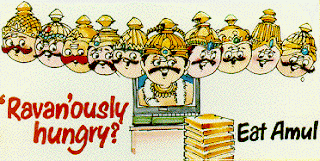Airtel is a telecommunications company based in India, owned by Bharti Airtel Limited. Airtel was founded on July 7, 1995 by Sunil Bharti Mittal. Its headquarters are in New Delhi, India.
Airtel is the largest cellular service provider in India with about 155.8 million subscribers. It is the market leader in India with about 27.61% market shares. It is the fifth largest mobile operator in the world with over 207.8 million subscribers across 19 countries.
The company started out by providing mobile services at first. But now it has expanded and is structured into 4 business units, namely, mobile, broadband services, digital television, and 3G services.
In 2003 Airtel launched its new brand campaign ‘Express Yourself’. The ‘express yourself’ ad conveys strong messages to the audience without really talking to them. Just by using simple words and effective visuals they have efficiently managed to deliver their message to their audience which is to ‘express themselves’.
Airtel rebranded itself in India on November 18, 2010. This was the first phase of a global rebranding of the brand. One of the reasons for this rebranding is because Airtel needed a more modern, refreshing and young look for recognition across a diverse international market. This youthful and international look was achieved through its new logo designed by a London-based brand agency Brand Union. According to Sanjay Kapoor, the CEO of Airtel, the new logo has 'airtel' written in lowercase which shows humility and appears friendlier than the previous logo.
Airtel positions itself as a brand that connects people with their loved ones. It doesn’t just stick to targeting the urban population but also focuses on the rural population, since it believes that it’s not just the urban but also the rural population that wants to keep in touch with their loved ones. This feeling of staying connected is universal as is their motive to help people attain it.
The signature tune of Airtel was composed by the Indian music guru A. R. Rahman. It became hugely popular and was the most downloaded mobile music with over 150 million downloads. A new version of the song was released on November 18,2010, as part of the rebranding of the company. This version too was composed by A. R. Rahman.
The television ads for Airtel are created by JWT, New Delhi, India.
Airtel, like most other telecommunications brands (for example, Vodafone and Idea), does not use humour in its ads. Instead it tries to connect with its audience through deeper emotions, emotions involved in relationships between a parent and a child, a couple and also between friends. It even tried to strike a patriotic cord in the hearts of its audience through the ‘no barriers’ ad which showed that there would be no barriers between people (countries) if only they talked to each other.
The ad featuring A.R.Rahman was one of the first Airtel television ads. It shows how he came up with the signature tune of Airtel. By featuring A.R.Rahman amidst foreigners, the ad caters to a mixed audience, including people from Asia as well as Africa and the Channel Islands.
The Bharti Airtel ad touches the patriotic psyche of the Indian audience. By emphasising the word ‘indian’ in every example, the ad manages to establish a strong patriotic connection with the country’s audience.
The ‘join the dots’ ad explores the bond between a child and a parent. It shows how a father can be there for his child when she needs him, even in impossible work situations. This ad exploits the ‘cute’ factor when the child is seen talking on the phone with her father. Using a cute child in the ad enables the advertisers to win the audience over, since children are always good at connecting at a deeper level with people.
With the introduction of 3G services, the ads of Airtel too have become more international and contemporary. This caters to today’s modern generation.
The ‘endless goodbyes’ ad shows how lovers won’t have to stay apart from each other. This is made possible through the 3G services, which allows them to make video calls online, and this will help them to constantly be with each other virtually.
The ad which says that Airtel helps you carry your entertainment wherever you go, tells the audience that with the 3G services that Airtel is providing, the audience can constantly browse the internet, download and listen to music and watch videos online, no matter where they go.
Coming to the print ads for Airtel, all of them work effectively in selling their respective ideas.
The ad which features Kareena is quite a simple ad. But it does the trick, since it has Kareena in it, and who wouldn’t want to win a date with Kareena.
According to a survey conducted by Airtel, it was found that people make calls to the same four or five people most of the time. The ad for the ‘special 5’ plan works well because it uses children to put across the message effectively. It says that people could use this particular plan and make calls to the five people closest to them at a lower rate.
 The ad for the Airtel broadband connection shows teenage boys playing videos games, and the various game options which are available to them on the internet. This tells the viewer that the broadband connection provided by Airtel is fast and can even be used for fun activities like playing games online.
The ad for the Airtel broadband connection shows teenage boys playing videos games, and the various game options which are available to them on the internet. This tells the viewer that the broadband connection provided by Airtel is fast and can even be used for fun activities like playing games online. 
 And lastly the two print ads for the ‘Airtel digital TV’ and ‘Airtel internet 3G par’ exploits the relationship between couples to put their idea across. The ad featuring Kareena and Saif was launched around new year’s. In this ad the advertisers have made use of the idea to ‘surprise your spouse with the perfect gift this new year’.The other ad that shows a couple sitting back-to-back listening to music together is an ad for the 3G services provided by Airtel, which shows that you can enjoy music with your loved one with an Airtel internet connection, anywhere.
And lastly the two print ads for the ‘Airtel digital TV’ and ‘Airtel internet 3G par’ exploits the relationship between couples to put their idea across. The ad featuring Kareena and Saif was launched around new year’s. In this ad the advertisers have made use of the idea to ‘surprise your spouse with the perfect gift this new year’.The other ad that shows a couple sitting back-to-back listening to music together is an ad for the 3G services provided by Airtel, which shows that you can enjoy music with your loved one with an Airtel internet connection, anywhere. I would like to conclude by saying that Airtel would not have been the market leader in India, had it not been for these effective ads made by JWT, which has done an extremely good job in positioning Airtel in the Indain as well as the international market.






